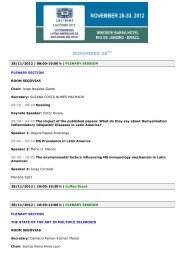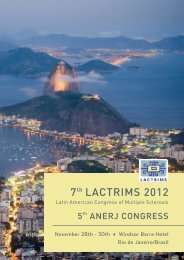Keynote Conference - Interevent
Keynote Conference - Interevent
Keynote Conference - Interevent
Create successful ePaper yourself
Turn your PDF publications into a flip-book with our unique Google optimized e-Paper software.
Symp#4 Cell Biology & Reproduction<br />
Chair Luiz Renato França<br />
Spermatogonial Stem Cell Niche in Vertebrates<br />
Luiz R França<br />
Luiz Renato França,Paulo HA Campos Júnior, Guilherme MJ Costa, Samyra SMSN Lacerda, Gleide F Avelar, Alana L Sousa,<br />
*Marie-Claude Hofmann<br />
Laboratory of Cellular Biology, Dept. of Morphology, ICB/UFMG, Belo Horizonte, MG, Brazil. *MD Anderson Cancer Center,<br />
Dept. of Endocrine Neoplasia and Hormonal Disorders, Houston, TX, USA (email: lrfranca@icb.ufmg.br)<br />
Spermatogonial stem cells (SSCs) are located in a particular environment called the “niche” that is controlled by the<br />
basement membrane, key testis somatic cells, and factors originating from the vascular network. Although crucial for SSC<br />
physiology, the niche is still poorly understood, particularly in non-model vertebrates where the testis cytoarchitecture<br />
could provide important cues for niche components and regulation. Recently, we demonstrated that A und GFRA1 + cells<br />
present preferential location (nearby blood vessels) in vertebrate species other than mouse and rat, such as zebrafish,<br />
bullfrog, turtle and horse. Additionally, we observed that peccaries present a peculiar Leydig cell (LC) distribution,<br />
whereby these cells situate around lobes of seminiferous tubules. Since the role of LCs as a niche component is not yet<br />
clearly elucidated, this feature makes the peccary an interesting model for investigating the SSC niche. Subsequently, we<br />
observed that in peccaries, ~93% of A undspermatogonia are GFRA1 + and that these cells are preferentially located adjacent<br />
to the interstitium without LCs. Moreover, the expression of CSF-1 was observed in LCs and peritubular myoid cells (PMCs)<br />
while its receptor was present in LCs and in GFRA1 + A und. In summary, besides reinforcing the fundamental role of Sertoli<br />
cells in GDNF-GFRA1 signaling for SSC self-renewal in vertebrates, our data suggest that the mechanisms involved in SSC<br />
physiology may be conserved in vertebrates. However, our peccary findings indicate that, contrary to PMCs, LCs might<br />
play a minor role in the SSC niche/physiology and that LCs are probably involved in the differentiation of A und toward type<br />
A1 spermatogonia.<br />
Fetal Testis Differentiation and Function, its Regulation and its Disorders<br />
Richard M Sharpe, Rod Mitchell, Afshan Dean, Karen Kilcoyne, Sophie Platts, Ashley Boyle, Sheila Macpherson, Chris<br />
McKinnell, Richard Anderson, Sander van den Driesche<br />
MRC Centre for Reproductive Health, The Queen’s Medical Research Institute, University of Edinburgh, UK (contact:<br />
r.sharpe@ed.ac.uk)<br />
Differentiation of the testis represents the first step along the pathway to becoming a male. Understanding of the<br />
processes that regulate testis differentiation have added importance because there is increasing evidence that the<br />
commonest disorders of human male reproductive health may largely stem form this period in life. Thus the testicular<br />
dysgenesis syndrome (TDS) hypothesis proposes that subnormal ‘set-up’ of the fetal testis/cell types leads to subnormal<br />
function (especially of the fetal Leydig cells) which, in turn, leads to male reproductive disorders that manifest at birth<br />
(cryptorchidism, hypospadias, micropenis) or in adulthood (low sperm count, low-normal testosterone, testis germ cell<br />
cancer). Direct evaluation of this hypothesis in humans is difficult, so we have used a rat model of TDS (fetal exposure to<br />
dibutyl phthalate; DBP) to help elucidate key mechanisms and cell-cell relationships in the fetal testis, disruption of which<br />
leads to TDS disorders. These have helped identify the masculinisation programming window (MPW) within which<br />
testosterone production by fetal Leydig cells is critical for determining normality and ultimate adult size of all male<br />
reproductive organs; deficiency in testosterone production in the MPW determines risk of later TDS disorders and can be<br />
‘measured’ retrospectively by anogenital distance (AGD). Our studies show that DBP-induced focal dysgenesis<br />
(malformation of seminiferous cords, intratubular Leydig cells, mis-specification of somatic cells) is closely interlinked with<br />
deficiency in testosterone production in the MPW, even though the dysgenesis manifests after the MPW. The mechanisms<br />
and factors involved, insofar as they are understood, will be discussed.<br />
Antimicrobial Proteins Secreted by the Epididymis<br />
Maria Christina W. Avellar<br />
Section of Experimental Endocrinology, Department of Pharmacology, Universidade Federal de São Paulo – Escola Paulista<br />
de Medicina (UNIFESP-EPM), São Paulo, SP, 04044-020, Brazil.<br />
This presentation will focus on the expression and regulation of naturally occurring antimicrobial proteins secreted by the<br />
epididymis. Aspects of the pattern of expression of mRNA and protein for selected genes, highlighting isoforms expressed<br />
by the beta-defensin SPAG11B gene, in the adult tissue and during development of the rat epididymis will be discussed.<br />
The effects of androgens, luminal fluid, glucocorticoids and exposure to in vivo bacterial products on their expression and<br />
immunolocalization will be also presented. Financial Support: FAPESP, CNPq, CAPES and Fogarty International Center<br />
(subcontract UNIFESP-EPM/University of North Carolina at Chapel Hill, USA). Email: avellar@unifesp.br.<br />
56





